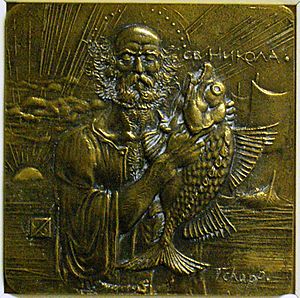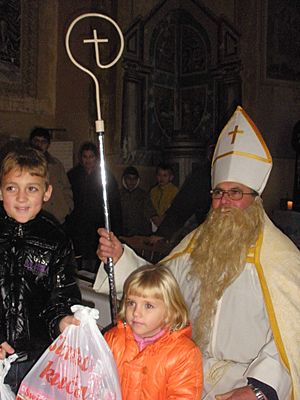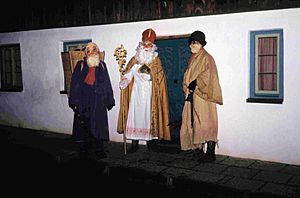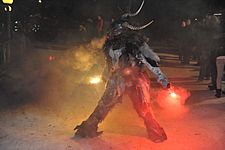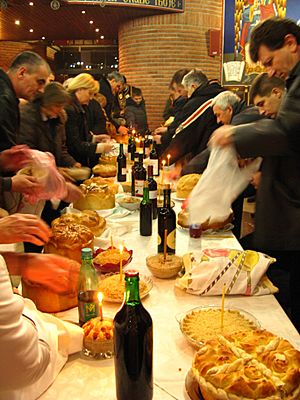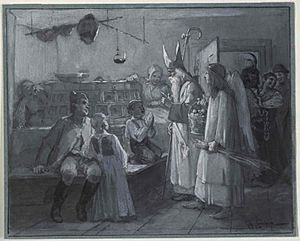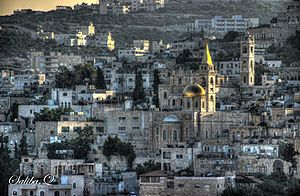Saint Nicholas Day facts for kids
Quick facts for kids Saint Nicholas Day |
|
|---|---|
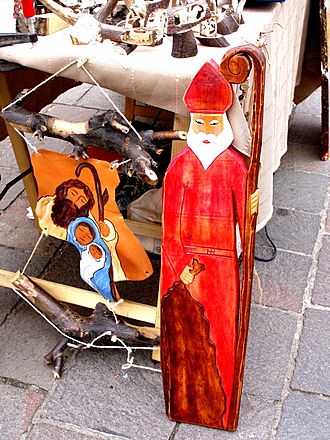
A depiction of Saint Nicholas with his sack standing next to a Nativity Scene
|
|
| Observed by | Anglicanism, Catholicism, Eastern Orthodoxy, Lutheranism, Methodism, Reformed |
| Type | Christian |
| Significance | Feast day of Saint Nicholas |
| Celebrations | placing shoes in the foyer before bedtime |
| Observances | Attending Mass or other service of worship |
| Date | 5/6 December (Western Christianity and Eastern Christianity on the New Calendar); 19 December (Eastern Christianity on the Old Calendar) |
| Frequency | annual |
Saint Nicholas Day, also known as the Feast of Saint Nicholas, is a special day celebrated by Christians. It usually happens on December 6th in Western countries, or on December 19th in Eastern countries that follow an older calendar. This day honors Nicholas of Myra, who was known for giving gifts to people.
In countries like Germany and Poland, boys used to dress up as bishops. They would ask for money to help people who were poor. In Ukraine, children hope that Saint Nicholas will put a present under their pillows. This happens if they have been good during the year. If they were naughty, they might find a twig or a piece of coal instead! In the Netherlands, kids put out a clog (a type of shoe) with hay and a carrot. These are for Saint Nicholas's horse. On this day, gifts often have funny poems written by the person giving them. In the United States, some children leave their shoes in the foyer on Saint Nicholas Eve. They hope Saint Nicholas will leave some coins inside.
The American Santa Claus and the British Father Christmas both come from the stories of Saint Nicholas. The name "Santa Claus" even comes from the Dutch name for the saint, Sinterklaas. However, Santa Claus and Father Christmas give gifts on Christmas Day, not on Saint Nicholas Day itself. There's a story that Saint Nicholas saved three children who were lost. A butcher had kidnapped them, but Saint Nicholas rescued them and brought them back to their parents. Many European countries celebrate Christmas from December 5th to December 25th. In the U.S., Saint Nicholas Day is not a widely celebrated public holiday.
Contents
Traditions Around the World
Europe
Balkans

In Albania, Saint Nicholas is called Shen'Kollë. Many Catholic families honor him. His feast day is celebrated on the evening of December 5th. This is known as Shen'Kolli i Dimnit (Saint Nicholas of Winter). They also celebrate on the evening of May 8th, when his bones were moved to Bari. This day is called Shen'Kolli i Majit (Saint Nicholas of May). Albanian Catholics sometimes swear by Saint Nicholas, showing how important he is. On the evening before his feast day, Albanians light a candle and do not eat meat. They prepare a big meal of roasted lamb and pork. Guests are served after midnight and greet each other with blessings.
In Greece, Saint Nicholas is not mainly linked to gift-giving. That tradition belongs to St. Basil, celebrated on New Year's Day. St. Nicholas is the protector of sailors. He is seen as the patron saint of the Greek Navy, for both military and merchant ships. His day is celebrated with parties on all ships and boats. It is also connected to other saint days around it, like St. Barbara (December 4th) and St. Savvas (December 5th). These days are often called the "Nikolobárbara" together. They are seen as the start of truly cold winter weather.
In Serbia, Saint Nicholas is the most celebrated family patron saint. His feast day is called Nikoljdan. Since Nikoljdan is during the time before Christmas when people often eat a special diet for religious reasons, it is celebrated with certain food rules. This means avoiding animal products like meat, milk, cheese, and eggs. Fish can be eaten on some days.
In Bulgaria, Saint Nicholas Day is celebrated on December 6th as Nikulden. Families invite relatives and friends for a meal of fish. This is usually ribnik, which is carp wrapped in dough. They also have two special loaves of bread. All the food is blessed at church or at home. The host waves incense over the table, then lifts and breaks the bread. Bulgarians also celebrate December 6th as a name day for people named Nikola, Nikolay, Kolyo, Nikolina, and similar names.
Belgium, Netherlands, Luxembourg and Lower Rhineland (Germany)
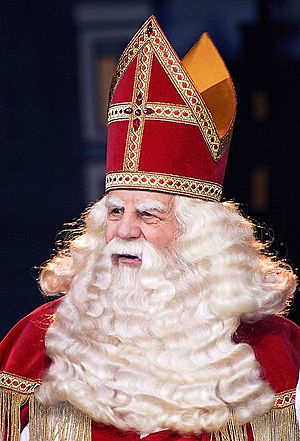
In the Netherlands, the main day for giving gifts is December 5th. In Belgium, they celebrate Sinterklaas on the morning of December 6th.
In the days leading up to December 5th or 6th, young children put their shoes in front of chimneys. They sing Sinterklaas songs. Often, they put a carrot or hay in their shoes for St. Nicholas's horse. The next morning, they find a small present in their shoes. These can be sweets, marbles, or small toys. On the evening of December 5th, people dressed as Sinterklaas bring presents to children who have been good. In reality, most children get gifts. This is often done by leaving a bag of presents outside the house. Someone might knock on the door or window, pretending to be Sinterklaas's helper. Sometimes, someone dresses up as Sinterklaas and gives the presents in person. Sinterklaas wears a bishop's red cape and hat. He is helped by many playful helpers called 'Zwarte Pieten' ("Black Petes"). They have black faces and colorful clothes.
In the past, it was said that the Zwarte Pieten would put naughty children into sacks. Then Sinterklaas would take them to Spain. This was meant to scare children. Today, some people discuss whether Zwarte Piet is appropriate. Some feel it is linked to slavery history. Others say the black skin comes from his job as a chimney sweep, delivering packages through chimneys.
In recent years, Christmas and Santa Claus have become more popular for gift-giving. However, for young children, Saint Nicholas Eve is still more important than Christmas.
In Luxembourg, Kleeschen is joined by the Houseker. This is a scary helper wearing a brown monk's robe.
Eastern Europe
In Slovenia, Miklavž (Sveti Miklavž) and in Croatia, Nikolaus (Sveti Nikola) visit on Saint Nicholas Day. They bring gifts to children who have been good. They encourage them to keep being good. If children have been naughty, they might get a visit from "Parkelj" or Krampus. These figures traditionally leave a rod, which parents might use for discipline.
In the Czech Republic and Slovakia, Mikuláš is often joined by an angel. The angel balances out the scary devil or Knecht Ruprecht. In these countries, children find candy and small gifts under their pillows or in their shoes. This happens on the evening of December 5th or the morning of December 6th.
In Hungary, Croatia, and Romania, children usually leave their boots on the windowsill on the evening of December 5th. By the next morning, Nikolaus (Szent Miklós or Mikulás in Hungary, or Moş Nicolae in Romania) leaves candy and gifts if they have been good. If they have been naughty, they might get a rod. Most children get small gifts, but also a small rod. In Hungary and Croatia, he is often joined by the Krampusz. This is a scary helper who is said to take away the bad children.
In Slovenia, Saint Nikolaus (Miklavž) is joined by an angel and a devil (parkelj).
In Ukraine, St. Nicholas (Mykolay) visits good children during the night of December 18th-19th. He puts presents under their pillows. For naughty children, Mykolay brings a rod. Usually, Mykolay is joined by an Angel (Janhol) and a Devil (Chort).
France
Saint Nicholas is mainly celebrated in regions like Alsace and Lorraine. He is their patron saint. A small donkey carries baskets full of gifts for children, biscuits, and sweets. Families get ready for the saint's arrival on December 6th. Grandparents tell stories about the saint. The most popular story is about three children who got lost. A wicked butcher tricked them into his shop, killed them, and put them in a large tub. With St. Nicholas's help, the boys were brought back to life and returned to their families. This made him known as a protector of children. The evil butcher, called Père Fouettard, has followed St. Nicholas ever since as a punishment. In France, statues and paintings often show this event, with the saint and children in a barrel.
Bakeries are busy making spiced gingerbread biscuits and mannala. These are brioche breads shaped like the saint. In schools, children learn songs and poems about St. Nicholas. In nurseries, a man playing St. Nicholas gives out chocolates and small presents. He is sometimes joined by an actor playing Père Fouettard. Père Fouettard carries sticks to warn children who might be naughty.
Central Europe
In Northern Germany, Sankt Nikolaus is usually a smaller celebration. Many children put a boot called Nikolaus-Stiefel outside their front door on the night of December 5th. St. Nicholas fills the boot with gifts and sweets overnight. He also checks if the children were good and helpful. If they were not, they might find a stick in their boots instead. Nicholas is often shown with Knecht Ruprecht. Knecht Ruprecht asks children if they have said their prayers. If not, he might shake his bag of ashes at them or hit them with a stick.
Sometimes, someone dressed as Nikolaus visits children at school or at home. He asks them if they have been good and gives out presents based on their behavior. This tradition has become softer over the years. In more Catholic areas, St. Nikolaus looks like a bishop and rides a horse. He is welcomed by large crowds. He has a long beard and loves children, unless they have been naughty.
In Austria, Bavaria, and Tyrol, St. Nicholas is joined by Krampus. Krampus is a creature that looks like a beast, often like a demon. Krampus is thought to punish children who misbehaved during the winter season. He might even capture very naughty children in his sack and take them away. This creature comes from old German stories. December 5th is Krampus Night or Krampusnacht. On this night, the hairy devil appears on the streets. Young men dress up as Krampus and roam the streets, making noise with chains and bells to scare children. Sometimes Krampus is with St. Nicholas, and sometimes he is alone. St. Nicholas gives gifts, while Krampus brings coal and bundles of sticks.
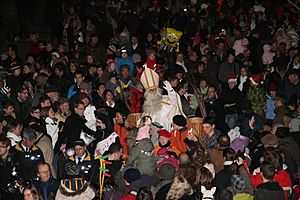
In Swiss folklore, St. Nicholas is known as Samichlaus. He is joined by the Schmutzli, a scary helper wearing a brown monk's robe. The person who brings Christmas gifts in Switzerland is not Samichlaus, but the Christchindli.
Italy
St. Nicholas (San Nicola) is the patron saint of Bari, a city where he is believed to be buried. A big celebration called the Festa di San Nicola is held from May 7th to 9th. On May 8th, the saint's relics are carried on a boat in the sea, with many other boats following. This is called Festa a mare. Since Saint Nicholas is said to protect children and young women, on December 6th there is a ritual called the Rito delle nubili. Unmarried women who want to find a husband can go to an early morning Mass. There, they walk around a column seven times. A similar tradition is in Sassari, where gifts are given to young women who need help getting married on Saint Nicholas Day.
In some parts of Italy, like Trieste, Udine, Belluno, and South Tyrol, St. Nicholas (San Nicolò) is celebrated with gifts for children on the morning of December 6th. There is also a fair called Fiera di San Nicolò in early December. For some families, this celebration is more important than Christmas.
Like in Austria, in South Tyrol Saint Nicholas comes with krampuses. But in Val Canale, Saint Nicholas comes to chase the krampuses away. After a parade of krampuses running after people, Saint Nicholas arrives on a chariot and gives gifts to children.
Malta
In Malta, St. Nicholas (San Nikola) is the patron saint of the town of Siġġiewi. His feast is celebrated on the last Sunday in June. The church there, dedicated to the saint, was built between 1676 and 1693.
Portugal
In the city of Guimarães in Portugal, St. Nicholas (São Nicolau) has been celebrated since the Middle Ages. He is the patron saint of high-school students. This celebration is called the Nicolinas. It is a group of parties that happen from November 29th to December 7th each year. This is not celebrated in the rest of Portugal.
Orthodox Slavic countries
Nikoljdan is the patron saint day for Saint Nicholas in Orthodox Slavic countries. It is celebrated on December 6th (or December 19th on the Julian calendar). Since this feast day is during a time when people eat a special diet before Christmas, the celebration follows certain food rules. This means eating a restricted diet, like no animal products. Fish can be eaten on some days.
Spain
St. Nicholas ("San Nicolás") is the patron saint of the University of Valladolid, one of Spain's old universities. He is also the patron saint of Alicante city.
Middle East
Lebanon
Saint Nicholas is celebrated by all Christian groups in Lebanon. Many places, churches, and schools are named after Saint Nicholas. Examples include Escalier Saint-Nicolas des Arts and Saint Nicolas Greek Orthodox Cathedral.
Palestine
Saint Nicholas is the patron saint of Beit Jala. This town is about 2 kilometers west of Bethlehem. The saint spent four years of his life there on a journey to the Holy Land. Every December 19th, a special church service is held in the Orthodox Church of St. Nicholas. This is usually followed by parades, shows, and other fun activities. People from all Christian groups in Beit Jala come to join the prayers and celebrations.
North America
While Saint Nicholas Day is not celebrated across the whole country, some cities in the United States do celebrate it. Cities with strong German roots, like Milwaukee, Wisconsin and Cincinnati, Ohio, celebrate St. Nick's Day in a similar way to German customs. Although it's not as common as in other countries, some people in the United States celebrate Saint Nicholas Day separately. They put their shoes outside their bedroom doors or hang an empty stocking by the fireplace on the evening of December 5th. St. Nicholas then comes during the night. On the morning of December 6th, these people find their shoes or stockings filled with gifts and sweet treats. This tradition has become more popular among German, Polish, Belgian, and Dutch communities across the United States.
Americans who celebrate Saint Nicholas Day usually also celebrate Christmas Day (December 25th) as a different holiday. Some Christmas traditions, like leaving out a shoe or stocking to be filled, are similar to Saint Nicholas Day traditions.
|
See also
 In Spanish: San Nicolás (fiesta) para niños
In Spanish: San Nicolás (fiesta) para niños


